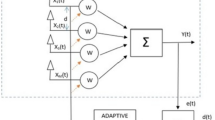Abstract
This paper discusses inner bound and outer bound for the total number of spatial degrees of freedom (DoF) of the K-user MIMO interference channel with only local channel state information at each transmitter when channel extensions are disabled over time and frequency dimensions. We firstly provide a constructive proof of the achievability of the DoF based on zero forcing for two-user MIMO interference channel with \(M_{1},M_{2}\) antennas at transmitter 1, 2 and \(N_{1},N_{2}\) antennas at the corresponding receivers when only local channel state information (CSI) is available at the transmitters. Then the total achievable DoF and interference management scheme for 3-user interference channel with specific antenna configuration is presented by comparing the number of equations and the number of variables. We apply interference zero-forcing scheme and signal subspace analysis on the generalization of the interference management for this special case to the common 3-user and K-user MIMO symmetric interference channel and establish that the the inner bound on total spatial DoF \(\min ({K\min (M_{t}, N_{r}), \max (M_{t}, N_{r})})\) is achievable in K-user MIMO symmetric interference channel with \(M_{t}\) transmitter antennas and \(N_{r}\) receiver antennas. We also provide the proof of an outer bound on spatial DoF for the K-user MIMO symmetric interference channel with only local CSI at each transmitter and indicate that the inner bound and outer bound are tight when the number of receiver antennas is not less than the number of transmitter antennas.





Similar content being viewed by others
References
Tse, D. N. C., Viswanath, P., & Lizhong, Z. (2004). Communication on the Grassmann manifold: A geometric approach to the noncoherent multiple-antenna channel. IEEE Transactions on Information Theory, 50(9), 1859–2004. doi:10.1109/TIT.2004.833347.
Telatar, E. (2002). Capacity of multi-antenna Gaussian channel. European Transactions on Telecommunications (ETT), 10(6), 585–596. doi:10.1002/ett.4460100604.
Lizhong, Z., & Tse, D. N. C. (2002). Communication on the Grassmann manifold: A geometric approach to the noncoherent multiple-antenna channel. IEEE Transactions on Information Theory, 48(2), 359–383. doi:10.1109/18.978730.
Jafar, S. A., & Fakhereddin, M. J. (2007). Degrees of freedom for the MIMO interference channel. IEEE Transactions on Information Theory, 53(7), 2637–2642. doi:10.1109/TIT.2007.899557.
Cadambe, V. R., & Jafar, S. A. (2008). Interference alignment and degrees of freedom of the K-user interference channel. IEEE Transactions on Information Theory, 54(8), 3425–3441.10. doi:1109/TIT.2008.926344.
Jun, S., Yingzhuang, L., & Guangxi, Z. (2010) On the degrees of freedom of the cellular network. In 2010 IEEE International Conference on Communications (ICC), 23–27 May 2010 (pp. 1–5). doi:10.1109/ICC.2010.5502363.
Chiachi, H., Jafar, S. A., Shamai, S., & Vishwanath, S. (2012). On degrees of freedom region of MIMO networks without channel state information at transmitters. IEEE Transactions on Information Theory, 58(2), 849–857. doi:10.1109/tit.2011.2173615.
Zhu, Y., & Guo, D. (2010). The degrees of freedom of MIMO interference channels without state information at transmitters. arXiv:1008.5196.
Yan, Z., & Dongning, G. (2012). The degrees of freedom of isotropic MIMO interference channels without state information at the transmitters. IEEE Transactions on Information Theory, 58(1), 341–352. doi:10.1109/tit.2011.2167314.
Tiangao, G., Chenwei, W., & Jafar, S. A. (2011). Aiming perfectly in the dark-blind interference alignment through staggered antenna switching. IEEE Transactions on Signal Processing, 59(6), 2734–2744. doi:10.1109/TSP.2011.2129517.
Jafar, S.A. (2010). Exploiting channel correlations—simple interference alignment schemes with no CSIT. In Global Telecommunications Conference (GLOBECOM 2010), 2010 IEEE, 6–10 December 2010 (pp. 1–5). doi:10.1109/GLOCOM.2010.5683592.
Gomadam, K., Cadambe, V. R., & Jafar, S. A. (2011). A distributed numerical approach to interference alignment and applications to wireless interference networks. IEEE Transactions on Information Theory, 57(6), 3309–3322. doi:10.1109/TIT.2011.2142270.
Peters, S. W., & Heath, R. W. (2009) Interference alignment via alternating minimization. In IEEE international conference on acoustics, speech and signal processing, 2009. ICASSP 2009, 19–24 April 2009 (pp. 2445–2448). doi:10.1109/ICASSP.2009.4960116.
Santamaria, I., Gonzalez, O., Heath, R.W., & Peters, S.W. ( 2010). Maximum sum-rate interference alignment algorithms for MIMO channels. In Global Telecommunications Conference (GLOBECOM 2010), 2010 IEEE, 6–10 December 2010 (pp. 1–6). doi:10.1109/GLOCOM.2010.5683919.
Hakjea, S., Seok-Hwan, P., Kyoung-Jae, L., & Inkyu, L. (2010). Linear precoder designs for K-user interference channels. IEEE Transactions on Wireless Communications, 9(1), 291–301. doi:10.1109/TWC.2010.01.090221.
Shen, H., Li, B., Tao, M. X., & Wang, X. D. (2010). MSE-based transceiver designs for the MIMO interference channel. IEEE Transactions on Wireless Communications, 9(11), 3480–3489. doi:10.1109/twc.2010.091510.091836.
Ho, Z.K.M., & Gesbert, D. (2010) Balancing egoism and altruism on interference channel: The MIMO case. In 2010 IEEE international conference on communications (ICC), 23–27 May 2010 (pp. 1–5). doi:10.1109/ICC.2010.5501882
Yetis, C. M., Tiangao, G., Jafar, S. A., & Kayran, A. H. (2010). On feasibility of interference alignment in MIMO interference networks. IEEE Transactions on Signal Processing, 58(9), 4771–4782. doi:10.1109/TSP.2010.2050480.
Bresler, G., Cartwright, D., & Tse, D. (2011). Settling the feasibility of interference alignment for the MIMO interference channel: The symmetric square case. arXiv:1104.0888.
Razaviyayn, M., Lyubeznik, G., & Zhi-Quan, L. (2012). On the degrees of freedom achievable through interference alignment in a MIMO interference channel. IEEE Transactions on Signal Processing, 60(2), 812–821. doi:10.1109/tsp.2011.2173683.
Acknowledgments
This work was supported in part by the Key Project of National Natural Science Foundation of China under grant 61231007, the National Science and Technology Major Project of the Ministry of Science and Technology of China under grant 2011ZX03003-001-04 and 2013ZX03003015-005, the National High Technology Research and Development Program of China (863 Program) under grant 2012AA121604 and 2014AA01A702, the Fundamental Research Funds for the Central Universities under grant 2042014kf0041, the International Science and Technology Cooperation Program of China under grant 2012DFG12010. Zhengmin Kong should be considered co-corresponding author.
Author information
Authors and Affiliations
Corresponding author
Rights and permissions
About this article
Cite this article
Peng, S., Liu, Y., Kong, Z. et al. Spatial Degrees of Freedom for MIMO Interference Channel with Local Channel State Information at Transmitters. Wireless Pers Commun 89, 639–662 (2016). https://doi.org/10.1007/s11277-016-3300-2
Published:
Issue Date:
DOI: https://doi.org/10.1007/s11277-016-3300-2




